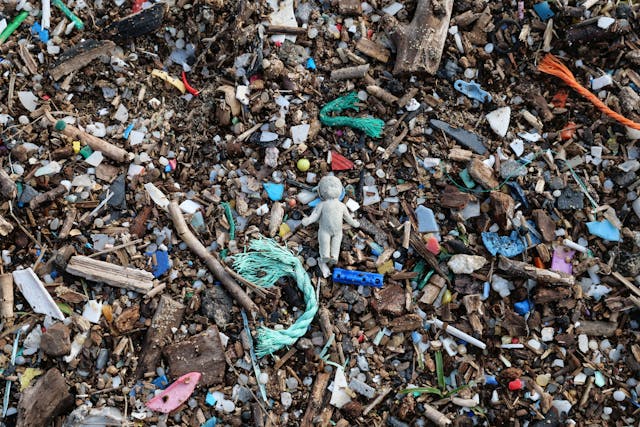
How do microplastics damage the body? The quick answer is that nobody really knows how microplastics damage the body, or even if they damage the body. The thinking is that they probably are harmful, but there hasn’t been enough research into how they are harmful or how harmful they are.
What are microplastics? Microplastics are pieces of plastic that are less than five millimeters long. That definition came into being n 2004, when a marine scientist discovered rice sized plastic bits on an English beech. Before that, people had not really considered the problem. A lot of microplastics are much smaller than 5 mm and many of them are nano-sized. It is impossible to know how many microplastics are out there because it is impossible to know how much plastic trash there is. One study in 2023 counted the number of microplastics in a small part of the ocean and extrapolated out. They estimated that there could be as many as 358 trillion plastic particles floating in the oceans. They have done this survey every year and they reported that microplastics first really appeared in 1990. Since then, they have risen year on year, which makes sense because the amount of plastic produced has risen year on year as well. The amount of microplastics really took off in 2012. Throughout most of the 20th century, things were generally made from natural products and plastic was gradually added in. Once manufacturers realized how much cheaper and easier to use plastic was over natural products, it increased until it had pretty much replaced natural materials in many products by the end of the century.
Microplastics are formed when plastic breaks down. Natural products, such as wood, biodegrade and the minerals and sugars contained within them are reused by the organisms that biodegrade them. Plastics don’t biodegrade. This is because plastic is not a natural material and there are no organisms that have evolved to break it down. Plastics are made of long chains of monomers that join together into polymers. The monomers are chains of carbon and carbon atoms that are bonded together and extremely strong. There is nothing like this in nature and no organism has evolved to break these polymers apart. However, the sun can break them apart. It takes a lot of energy to break polymers apart, which is why living organisms don’t do it. They would have to put in more energy than they would get out. The sun has that energy and when ultraviolet radiation hits plastic, over time, it breaks the long chains apart into smaller chains, and these are microplastics. Given enough time, the chains will completely break down, but that could take a thousand years or more.
So, what do microplastics do in the body? We all have microplastics inside us. They come from several different sources. Most marine life has microplastics in it. Fish eat the plastics, or they enter through the gills, and they end up in the fish’s blood stream, or in its flesh. Then we eat the fish and the plastic is inside us. They are inside other animals that we eat as well. Microplastics are in the water that we drink. Water treatment plants and water filters can catch many of the pieces, but they cannot catch the real small plastic pieces. And then we breathe in microplastics. They are so light that they float in the air and we just breathe them in.
Microplastics are found all over our bodies. They are in our lungs, in our blood, in breast milk, and they are passed along the umbilical cord to babies. There is nothing we can do about that. The question we are asking is how harmful they are and there is not enough evidence to show either way yet. The problem is so recent that there hasn’t been any time to study the long term effects. There are two extremes of opinion. The first is that microplastics won’t do anything to us. They will just sit there benignly in our bodies and do no damage. Just as bacteria cannot break them down, neither can our bodies, so they will just sit there. The opposing opinion is that they will do a lot of damage. Their sharp and irregular shapes can damage parts of our body or get trapped in places and either cause blockages or stimulate organs. They can impact the digestive system, respiratory system, and the immune system. They could damage our microbiome. They could get trapped and causing swelling, or even cancerous growths to form. And then there is the chemical damage. Most plastics contain toxic chemicals and these chemicals can interfere with hormones, lower oxygen levels in the blood, kill our bacteria, harm the immune system, make it hard to breathe, and damage the liver and kidneys. There is also a worry that they will be able to pass across the blood brain barrier and damage the brain.
There is not enough research or evidence yet to show how harmful microplastics are, but I think they are going to prove to be more harmful than the plastic industry would like us to believe. And this is what I learned today.
Try these next:
Sources
https://journals.plos.org/plosone/article?id=10.1371/journal.pone.0281596
https://pmc.ncbi.nlm.nih.gov/articles/PMC10151227
https://oceanservice.noaa.gov/facts/microplastics.html
https://www.livescience.com/33085-petroleum-derived-plastic-non-biodegradable.html
Photo by Sébastien Vincon: https://www.pexels.com/photo/photo-of-small-pieces-of-plastic-garbage-10143821/

Pingback: Is there anything that can eat plastic?